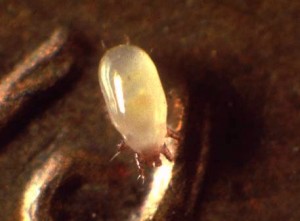What They Did and Didn’t Know
Changes in the environment occur naturally over geological periods, and in some cases are induced by human impact. These changes include ecological and climate events, such as algal blooms or El Niño years, and temporal changes in climate variables. Changes in environmental conditions are correlated with changes in demographic rates, which in turn are correlated with population dynamics. The consequences these changes have on populations is noteably one of the greatest challenges in biology. Generally, two groups of investigators have emerged: the first uses field data to assess populations while the second uses theoretical models.
Smallegange et al. (2014) combined both these investigative efforts to explore the impact of environmental change across a range of random environments on the response of life-history variables using a model organism. They used the bulb mite (Rhizoglyphus robini) because scientists already have detailed knowledge on how environmental quality affects its life-history. They predicted that different life-history variables respond correlatively to changes in the environment. Here, they defined life-history variables which would indicate average fitness and life-history speed across random environments, such as lifetime reproductive success and generation time.
Specifically, the researchers developed integral projection models (IPMs) to examine the most probable life-history response of populations to changes in (1) the frequency of favorable environmental conditions over time and (2) the similarity between environmental conditions as a function of time. Simply put, IPMs use information on how an individual’s state affects its vital rates (survival, growth, and reproduction) to make predictions about the population. Mathematically, they are developed from regression models which predict vital rates from state variables (size or age) and covariates (environment conditions).
What They Found
The researchers performed their experiment in 4 steps. The first step was to compare the population demography functions of the good and bad environment IPMs, which describe the associations between body size and survival, growth, and fertility for both environmental conditions. The second step was to conduct a perturbation analysis to investigate how either environmental change influences the relative importance of demographic rates to population growth rate. In the third step of the study, the researchers assessed which life-history variables were correlated to changes in noise color (white noise vs. red noise) and in frequencies of good environments. Finally, the fourth step involved the exploration of which quantities correlated with average population fitness with both aforementioned variables.
They obtained 2 major results from this study. Life-history speed can be shaped by both the frequency of good environmental conditions over time and the patterning of environmental conditions over time. Furthermore, as the frequency of good environmental conditions change and as noise color shifts between white (noise containing many frequencies with equal intensities) and red (noise produced by Brownian motion or random motion of particles in a fluid) environments, different quantities can change together in a consistent and predictable way: average fitness and lifetime reproductive success always correlate positively while generation time and body size always correlate negatively.
In this sense, Smallegange et al. (2014) supported their original prediction. Since their study was primarily investigatory in nature, they omitted any specific hypotheses. However this study serves as the first step towards answering the big question of environment and population relationships.
Why We Care
While these results seem overgeneralized and highly theoretical, they maintain their significance in the scientific community. This study was the first step toward identifying reliable predictors of life-history change, helping scientists understand the greater relationship between environment and populations. As such, this work provided the foundation toward understanding population dynamics in random environments and how random change influences the evolution of life-histories.
References:
Smallegange IM, Deere JA, Coulson T (2014) Correlative Changes in Life-History Variables in Response to Environmental Change in a Model Organism. The American Naturalist 183(6): 784-797.



